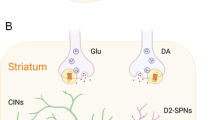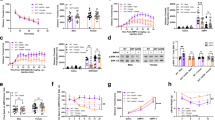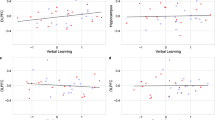Abstract
Inconsistent evidence implicates disruptions of striatal dopaminergic indices in suicide and major depression. To determine whether there are alterations in the striatal dopamine system in suicide, we conducted a quantitative autoradiographic survey of dopamine transporter (DAT; [3H]mazindol), D1 receptor ([3H]SCH23390), and D2 receptor ([3H]sulpiride) binding in the dorsal striatum postmortem from matched suicides and controls. Axis I and axis II psychiatric diagnosis, recent treatment history, and early life adversity (ELA) were determined by psychological autopsy. Mean DAT, D2, and D1 receptor binding did not differ in suicide. However, there was a positive correlation between D1 and D2 receptor binding in the dorsal striatum of control subjects (R2=0.31, p<0.05) that was not present in suicides (R2=0.00, p=0.97). In suicides and controls with reported ELA, there was no correlation between striatal DAT and D1 receptor binding (R2=0.07, p=0.33), although DAT and D1 receptor binding was positively correlated in subjects with no report of ELA (R2=0.32, p<0.05). After controlling for age, there were no significant ELA-related mean differences. Binding of D1 receptors and DAT throughout the striatum correlated negatively with age (D1 receptor: R2=0.12, p<0.05; DAT: R2=0.36, p<0.001). There appears to be an imbalance in dopaminergic receptor and transporter expression related to suicide that differs from that associated with ELA or age.
Similar content being viewed by others
Log in or create a free account to read this content
Gain free access to this article, as well as selected content from this journal and more on nature.com
or
References
Ainsworth K, Smith SE, Zetterstrom TS, Pei Q, Franklin M, Sharp T (1998). Effect of antidepressant drugs on dopamine D1 and D2 receptor expression and dopamine release in the nucleus accumbens of the rat. Psychopharmacology (Berl) 140: 470–477.
Allard P, Norlen M (1997). Unchanged density of caudate nucleus dopamine uptake sites in depressed suicide victims. J Neural Transm (Vienna) 104: 1353–1360.
Allard P, Norlen M (2001). Caudate nucleus dopamine D(2) receptors in depressed suicide victims. Neuropsychobiology 44: 70–73.
Andersen SL, Teicher MH (2009). Desperately driven and no brakes: developmental stress exposure and subsequent risk for substance abuse. Neurosci Biobehav Rev 33: 516–524.
Antonini A, Leenders KL (1993). Dopamine D2 receptors in normal human brain: effect of age measured by positron emission tomography (PET) and [11C]-raclopride. Ann NY Acad Sci 695: 81–85.
Backman L, Ginovart N, Dixon RA, Wahlin TB, Wahlin A, Halldin C et al (2000). Age-related cognitive deficits mediated by changes in the striatal dopamine system. Am J Psychiatry 157: 635–637.
Beckstead RM, Domesick VB, Nauta WJH (1979). Efferent connections of the substantia nigra and ventral tegmental area in the rat. Brain Res. 175: 191–217.
Bowden C, Cheetham SC, Lowther S, Katona CL, Crompton MR, Horton RW (1997). Dopamine uptake sites, labelled with [3H]GBR12935, in brain samples from depressed suicides and controls. Eur Neuropsychopharmacol 7: 247–252.
Brake WG, Zhang TY, Diorio J, Meaney MJ, Gratton A (2004). Influence of early postnatal rearing conditions on mesocorticolimbic dopamine and behavioural responses to psychostimulants and stressors in adult rats. Eur J Neurosci 19: 1863–1874.
Bruffaerts R, Demyttenaere K, Borges G, Haro JM, Chiu WT, Hwang I et al (2010). Childhood adversities as risk factors for onset and persistence of suicidal behaviour. Br J Psychiatry 197: 20–27.
Calabresi P, Maj R, Mercuri NB, Bernardi G (1992). Coactivation of D1 and D2 dopamine receptors is required for long-term synaptic depression in the striatum. Neurosci Lett 142: 95–99.
Dougherty DD, Bonab AA, Ottowitz WE, Livni E, Alpert NM, Rauch SL et al (2006). Decreased striatal D1 binding as measured using PET and [11C]SCH 23,390 in patients with major depression with anger attacks. Depress Anxiety 23: 175–177.
Drury SS, Brett ZH, Henry C, Scheeringa M (2013). The association of a novel haplotype in the dopamine transporter with preschool age posttraumatic stress disorder. J Child Adolesc Psychopharmacol 23: 236–243.
Dunlop BW, Nemeroff CB (2007). The role of dopamine in the pathophysiology of depression. Arch Gen Psychiatry 64: 327–337.
Enoch MA (2011). The role of early life stress as a predictor for alcohol and drug dependence. Psychopharmacology (Berl) 214: 17–31.
Farde L, Wiesel FA, Jansson P, Uppfeldt G, Wahlen A, Sedvall G (1988). An open label trial of raclopride in acute schizophrenia. Confirmation of D2-dopamine receptor occupancy by PET. Psychopharmacology (Berl) 94: 1–7.
Gerfen CR (1985). The neostriatal mosaic. I. Compartmental organization of projections from the striatum to the substantia nigra in the rat. J Comp Neurol 236: 454–476.
Glick SD, Lyon RA, Hinds PA, Sowek C, Titeler M (1988). Correlated asymmetries in striatal D1 and D2 binding: relationship to apomorphine-induced rotation. Brain Res 455: 43–48.
Jastrow TR, Richfield E, Gnegy ME (1984). Quantitative autoradiography of [3H]sulpiride binding sites in rat brain. Neurosci Lett 51: 47–53.
Johnson JG, Cohen P, Gould MS, Kasen S, Brown J, Brook JS (2002). Childhood adversities, interpersonal difficulties, and risk for suicide attempts during late adolescence and early adulthood. Arch Gen Psychiatry 59: 741–749.
Kalivas PW, Volkow ND (2005). The neural basis of addiction: a pathology of motivation and choice. Am J Psychiatry 162: 1403–1413.
Kelly TM, Mann JJ (1996). Validity of DSM-III-R diagnosis by psychological autopsy: a comparison with clinician ante-mortem diagnosis. Acta Psychiatr Scand 94: 337–343.
Kemppainen N, Marjamaki P, Roytta M, Rinne JO (2001). Different pattern of reduction of striatal dopamine reuptake sites in Alzheimer's disease and ageing. J Neural Transm (Vienna) 108: 827–836.
Laasonen-Balk T, Kuikka J, Viinamaki H, Husso-Saastamoinen M, Lehtonen J, Tiihonen J (1999). Striatal dopamine transporter density in major depression. Psychopharmacology (Berl) 144: 282–285.
MacMillan HL, Fleming JE, Streiner DL, Lin E, Boyle MH, Jamieson E et al (2001). Childhood abuse and lifetime psychopathology in a community sample. Am J Psychiatry 158: 1878–1883.
Mann JJ (2000). The biology of suicide: the dimensional versus the diagnostic correlates. Eur Psychiatry 15: 278s–279s.
Meaney MJ, Brake W, Gratton A (2002). Environmental regulation of the development of mesolimbic dopamine systems: a neurobiological mechanism for vulnerability to drug abuse? Psychoneuroendocrinology 27: 127–138.
Memo M, Lucchi L, Spano PF, Trabucchi M (1980). Aging process affects a single class of dopamine receptors. Brain Res 202: 488–492.
Molnar BE, Berkman LF, Buka SL (2001). Psychopathology, childhood sexual abuse and other childhood adversities: relative links to subsequent suicidal behaviour in the US. Psychol Med 31: 965–977.
Morelli M, Mennini T, Cagnotto A, Toffano G, Di Chiara G (1990). Quantitative autoradiographical analysis of the age-related modulation of central dopamine D1 and D2 receptors. Neuroscience 36: 403–410.
Pitchot W, Reggers J, Pinto E, Hansenne M, Fuchs S, Pirard S et al (2001). Reduced dopaminergic activity in depressed suicides. Psychoneuroendocrinology 26: 331–335.
Pohjalainen T, Rinne JO, Nagren K, Syvalahti E, Hietala J (1998). Sex differences in the striatal dopamine D2 receptor binding characteristics in vivo. Am J Psychiatry 155: 768–773.
Pruessner JC, Champagne F, Meaney MJ, Dagher A (2004). Dopamine release in response to a psychological stress in humans and its relationship to early life maternal care: a positron emission tomography study using [11C]raclopride. J Neurosci 24: 2825–2831.
Przedborski S, Kostic V, Jackson-Lewis V, Cadet JL, Burke RE (1991). Effect of unilateral perinatal hypoxic-ischemic brain injury in the rat on dopamine D1 and D2 receptors and uptake sites: a quantitative autoradiographic study. J Neurochem 57: 1951–1961.
Rinne JO, Lonnberg P, Marjamaki P (1990). Age-dependent decline in human brain dopamine D1 and D2 receptors. Brain Res 508: 349–352.
Ruiz J, Gabilondo AM, Meana JJ, Garcia-Sevilla JA (1992). Increased [3H] raclopride binding sites in postmortem brains from schizophrenic violent suicide victims. Psychopharmacology (Berl) 109: 410–414.
Ryding E, Ahnlide JA, Lindstrom M, Rosen I, Traskman-Bendz L (2006). Regional brain serotonin and dopamine transporter binding capacity in suicide attempters relate to impulsiveness and mental energy. Psychiatry Res 148: 195–203.
Savitz JB, Drevets WC (2013). Neuroreceptor imaging in depression. Neurobiol Dis 52: 49–65.
Seeman P, Niznik HB, Guan HC, Booth G, Ulpian C (1989). Link between D1 and D2 dopamine receptors is reduced in schizophrenia and Huntington diseased brain. Proc Natl Acad Sci USA 86: 10156–10160.
Shen W, Flajolet M, Greengard P, Surmeier DJ (2008). Dichotomous dopaminergic control of striatal synaptic plasticity. Science 321: 848–851.
Suhara T, Fukuda H, Inoue O, Itoh T, Suzuki K, Yamasaki T et al (1991). Age-related changes in human D1 dopamine receptors measured by positron emission tomography. Psychopharmacology (Berl) 103: 41–45.
Suhara T, Nakayama K, Inoue O, Fukuda H, Shimizu M, Mori A et al (1992). D1 dopamine receptor binding in mood disorders measured by positron emission tomography. Psychopharmacology (Berl) 106: 14–18.
Surmeier DJ, Ding J, Day M, Wang Z, Shen W (2007). D1 and D2 dopamine-receptor modulation of striatal glutamatergic signaling in striatal medium spiny neurons. Trends Neurosci 30: 228–235.
Thibault D, Loustalot F, Fortin GM, Bourque MJ, Trudeau LE (2013). Evaluation of D1 and D2 dopamine receptor segregation in the developing striatum using BAC transgenic mice. PLoS One 8: e67219.
Torres GE, Gainetdinov RR, Caron MG (2003). Plasma membrane monoamine transporters: structure, regulation and function. Nat Rev Neurosci 4: 13–25.
Vallone D, Picetti R, Borrelli E (2000). Structure and function of dopamine receptors. Neurosci Biobehav Rev 24: 125–132.
Volkow ND, Ding YS, Fowler JS, Wang GJ, Logan J, Gatley SJ et al (1996). Dopamine transporters decrease with age. J Nucl Med 37: 554–559.
Wong AH, Liu F (2012). Uncoupling the dopamine D1-D2 receptor complex: a novel target for antidepressant treatment. Clin Pharmacol Ther 91: 298–302.
Xu J, Murphy SL, Kochanek KD, Bastian BA (2016). Deaths: final data for 2013. Natl Vital Stat Rep 64: 1–118.
Acknowledgements
We would like to acknowledge the invaluable contributions of the families of subjects involved in this study. Funding was provided by NIH grant 1P50 MH090964.
Author information
Authors and Affiliations
Corresponding author
Rights and permissions
About this article
Cite this article
Fitzgerald, M., Kassir, S., Underwood, M. et al. Dysregulation of Striatal Dopamine Receptor Binding in Suicide. Neuropsychopharmacol 42, 974–982 (2017). https://doi.org/10.1038/npp.2016.124
Received:
Revised:
Accepted:
Published:
Issue date:
DOI: https://doi.org/10.1038/npp.2016.124
This article is cited by
-
M6A RNA epitranscriptome dynamics linked to major depressive disorder and suicide risk
Neuropsychopharmacology (2025)
-
Postmortem evidence of decreased brain pH in major depressive disorder: a systematic review and meta-analysis
Translational Psychiatry (2024)
-
Psychobiological risk factors for suicidal thoughts and behaviors in adolescence: a consideration of the role of puberty
Molecular Psychiatry (2022)
-
A Comprehensive Review of the Literature on Sleep Difficulties and Suicidality in Youth to Inform an Integrative Developmental Model and Future Directions
Current Sleep Medicine Reports (2022)
-
Susceptibility to chronic immobilization stress‐induced depressive-like behaviour in middle‐aged female mice and accompanying changes in dopamine D1 and GABAA receptors in related brain regions
Behavioral and Brain Functions (2021)



